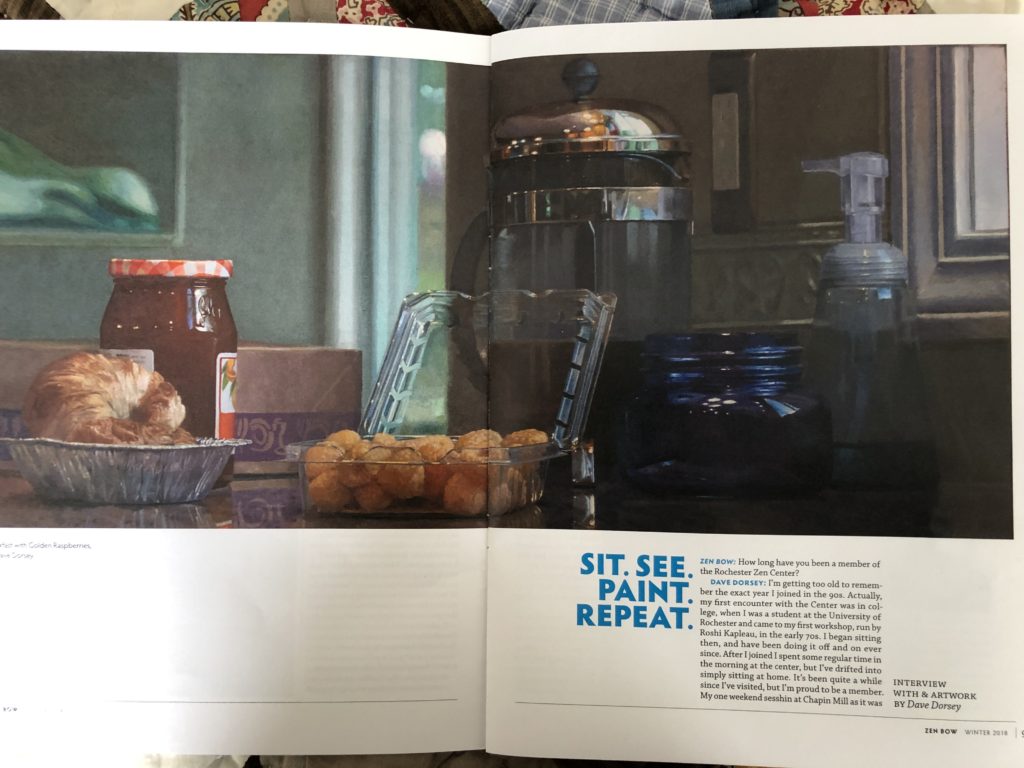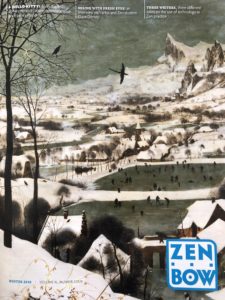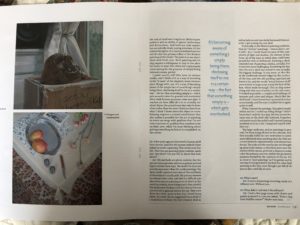Skulls and jars and unmethodical doubt
 I had a recent email conversation with Chris Pulleyn, an old friend, a former employer, and a central figure at the Rochester Zen Center, where I’ve been a member mostly in absentia for a couple decades. She asked me a few questions about the relationship between my still nascent meditation practice and my painting–so that she could publish some of my work and our conversation in the Center’s publication, Zen Bow. It was a wonderful gesture on the part of the people at the Center, and much appreciated. One thing that was fun about the conversation was that she had a hard time seeing common ground between the few paintings of skulls I’ve done—which struck her as very Buddhist, being emblems of mortality and impermanence—alongside my candy jars. It forced me to think about how much meditation has governed not only the energy I bring to painting, but also influenced my understanding about how painting works. What follows is a condensation of the Q/A in Zen Bow.
I had a recent email conversation with Chris Pulleyn, an old friend, a former employer, and a central figure at the Rochester Zen Center, where I’ve been a member mostly in absentia for a couple decades. She asked me a few questions about the relationship between my still nascent meditation practice and my painting–so that she could publish some of my work and our conversation in the Center’s publication, Zen Bow. It was a wonderful gesture on the part of the people at the Center, and much appreciated. One thing that was fun about the conversation was that she had a hard time seeing common ground between the few paintings of skulls I’ve done—which struck her as very Buddhist, being emblems of mortality and impermanence—alongside my candy jars. It forced me to think about how much meditation has governed not only the energy I bring to painting, but also influenced my understanding about how painting works. What follows is a condensation of the Q/A in Zen Bow.
 My first encounter with Zen was in college, when I was a student at the University of Rochester. With a friend from my dorm, I attended my first workshop, run by Philip Kapleau, the center’s founder, in the early 70s. I began sitting then, and have been doing it off and on ever since—constantly trying to establish a daily habit. After I joined as an actual member in the 90s, I spent some regular time in the morning at the center but I’ve drifted into simply sitting at home. It was more than taking up something like yoga. It was, for lack of a better word, a philosophical pursuit.
My first encounter with Zen was in college, when I was a student at the University of Rochester. With a friend from my dorm, I attended my first workshop, run by Philip Kapleau, the center’s founder, in the early 70s. I began sitting then, and have been doing it off and on ever since—constantly trying to establish a daily habit. After I joined as an actual member in the 90s, I spent some regular time in the morning at the center but I’ve drifted into simply sitting at home. It was more than taking up something like yoga. It was, for lack of a better word, a philosophical pursuit.
I came out of high school with a kind of corrosive sense of doubt: a tenacious questioning about the possibility of meaning that seemed urgent but unanswerable. The nature of this doubt is hard to describe without muddling it up, but it was difficult and life-changing and psychologically “totalizing,” to use a word I hear in other contexts now. After contending with this state of unrest for a couple years, as a freshman at UR, I finally got around to reading J.D. Salinger’s Glass family stories, which introduced me to a variety of spiritual traditions: Vedanta, Zen, Russian Orthodox Christianity. His fiction offered me an intersection of references to a variety of spiritual paths. I was so impressed by Salinger, in addition to my curriculum in English lit, I made out a reading list of Salinger’s favorite authors and read them, one after another, as if he had introduced me personally to each of the writers themselves and said, “you two should get to know each other.” Tolstoy, Dostoevsky, Proust, Henry James, Keats, Coleridge, and so on, (some of whom I’ve been going back to reread now after all this time.) As a result, I spent the summer after my freshman year at UR reading all of Proust and most of Kierkegaard. Kierkegaard was crucial—my parents were Presbyterian for a while in my teens, and I still consider myself a Christian who uses Tolstoy and Kierkegaard both as an excuse not to go to join a church, but a few of Kierkegaard insights were very close to the paradoxes one faces in Zen practice when trying to break through how the mind entraps itself without realizing it. (I think the conscious, egocentric mind is itself often a sort of self-sustaining trap.) In addition, I made a list of references to spiritual disciplines and other writers mentioned in Franny and Zooey: Ramakrishnma, Meister Eckhart, the Upanishads, the haiku translations of R.H. Blyth and D.T. Suzuki. That last name was the door to my interest in Zen. One thing led to another. In the middle of all this self-directed study, I was delighted to discover a new organization devoted to Buddhist meditation here where I lived. That’s how I started.
Painting began earlier. It was an outgrowth of playing a Fender guitar in a couple garage bands in high school. I wanted some large posters of Jimi Hendrix and Eric Clapton to put on my bedroom wall, but didn’t know where to find them—this was long before the Internet. During a brief illness, out of boredom, I found a starter set of oil paints my father had used once to make little Cubist-type scenes on Masonite he hung on our walls. I used them to copy the portrait of Mike Bloomfield by Norman Rockwell on the cover of “The Live Adventures of Mike Bloomfield and Al Kooper.” I still have that oil painting on paper—I discovered it a few weeks ago in the basement. I went from that to a 4’ x 4’ copy of the cover of Band of Gypsies that I bolted to my wall—it was painted on soft thick board, like acoustic ceiling tile. When I discovered an Art News Annual with a long feature about Van Gogh, my interest in painting began to take the place of my desire to play the guitar. And I’ve painted ever since. I chose to study literature and writing rather than painting because I didn’t entirely trust what was happening in the art world at the time and still feel wary about most of what goes on there—I wanted to keep my distance from it and yet still be an artist.
 I’m still a beginner at Zen. When I sit, I count my breaths. Even after decades, I can’t do it consistently even over short periods of time. I have to keep coming back to the counting after losing track, as most people do. I know all of this is just the doorstep to serious Zen practice, yet I think even this kind of effort is central to my painting in a couple ways. What painting, including my own, has in common with sitting is the need for sustained attention to the task at hand over long hours. Both require patience and an ability to ignore restlessness and distractions. And both not only require, but are entirely about, paying attention: it’s the central discipline of a representational painter and it’s also the primary effect of the finished painting on the viewer. The point is to see what’s there with fresh eyes—which means forgetting what you think is there. Both painting and sitting require a willingness to stay in one place for hours in ways that often feel unpleasantly constraining for the purpose of simply being intensely aware, period. I paint mostly still lifes now, in various modes, and I think of it as a way of attending to the simplest, most commonplace things with care. It’s a way of becoming aware of the simple fact of something’s simply being there, disclosing itself to me simply as what it is, which gets so easily taken for granted and overlooked when daily human purposes come into play. It also teaches me how difficult it is to actually see what I’m looking at: the actual tones that exist in front of me rather than the ones I believe are there from what I think I know about the object or scene. Painting requires a trained mindfulness that also makes it possible for the act of painting to invest an image with qualities that I’m not even conscious of, qualities that somehow arise on their own, while I’m busy thinking about getting something accomplished on the canvas.
I’m still a beginner at Zen. When I sit, I count my breaths. Even after decades, I can’t do it consistently even over short periods of time. I have to keep coming back to the counting after losing track, as most people do. I know all of this is just the doorstep to serious Zen practice, yet I think even this kind of effort is central to my painting in a couple ways. What painting, including my own, has in common with sitting is the need for sustained attention to the task at hand over long hours. Both require patience and an ability to ignore restlessness and distractions. And both not only require, but are entirely about, paying attention: it’s the central discipline of a representational painter and it’s also the primary effect of the finished painting on the viewer. The point is to see what’s there with fresh eyes—which means forgetting what you think is there. Both painting and sitting require a willingness to stay in one place for hours in ways that often feel unpleasantly constraining for the purpose of simply being intensely aware, period. I paint mostly still lifes now, in various modes, and I think of it as a way of attending to the simplest, most commonplace things with care. It’s a way of becoming aware of the simple fact of something’s simply being there, disclosing itself to me simply as what it is, which gets so easily taken for granted and overlooked when daily human purposes come into play. It also teaches me how difficult it is to actually see what I’m looking at: the actual tones that exist in front of me rather than the ones I believe are there from what I think I know about the object or scene. Painting requires a trained mindfulness that also makes it possible for the act of painting to invest an image with qualities that I’m not even conscious of, qualities that somehow arise on their own, while I’m busy thinking about getting something accomplished on the canvas.
My methods are photo-realistic, but the jars I’ve done are more painterly and not as precise as most hyper-realism these days if you get up close to them—though actually not as painterly as I’d like. The skulls are actually more exact than the candy paintings. The three skulls I painted were almost the antithesis of the subjects I usually pick. My primary interest has always been color and this is a difficult passion when you are painting most of what’s in the world accurately: most things aren’t that colorful. The skulls were the least colorful objects I’ve ever painted and a genuine detour for me. They were done on a dare, more or less, but I loved doing them. An artist I know in Brooklyn suggested I try a skull so I tried three of them, thanks to loans from Chris Pulleyn, as well as baboon and cow skulls a second Brooklyn artist, Susan Sills. I got to keep the cow skull. Technically, in the Western painting tradition, they are “vanitas” paintings—time is short, use it well—but I loved them because of the complexity of light and shadow, the texture of the bone, all of the ways in which they could have passed for rock or driftwood. Painting a skull reminded me of painting a dahlia, actually: but it was even more challenging. When Chris loaned me the human skull, she said it was a gift from her father who had used it as a teaching aid in dentistry school—and in that painting, rendering the box that he’d used to ship it to her was actually the biggest challenge. It was worn, so the ribs in the cardboard created ridges in the surface of the box, and the old packing tape had yellowed a bit, and the words “actual human skull” were written in large script across the face of the box, which made me laugh. (Try to ship something with that sort of notice on the side now.) It looked impossible, a complicated mélange of textures and colors and shapes. Much like the skull itself. I don’t know how I painted that box so accurately, and I’m sure I couldn’t do it again quite as well. When I started the painting, I thought it would defeat me but I ended up doing things I didn’t know that I could do. In a way, the box carried the same aura as the skull: old, battered, forgotten and pretty much discarded until I started paying attention to it for a bit.
The large candy jars, and jar paintings in general, I’ve been doing off and on for a decade, and they actually fulfill, more than anything else I do, one of my steadfast motivations: they are a balance between representation and abstraction and they are mostly about color. The scale and the way the jars are brought up close to the viewer, so that they seem near the surface of the canvas, gives me a chance to make color the primary concern, within the geometric patterns formed by the content of the jar. It’s as close to “pure painting” as I’ve gotten and is one way I’ve responded to my love for color field painting in the 60s, even though as a jar full of objects, it’s also a still life of sorts.
Comments are currently closed.